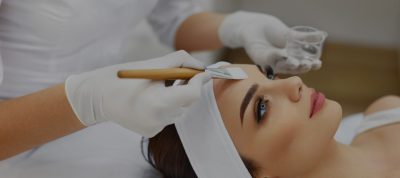Skin Cancer
Cancer is the uncontrolled replication of cells into tumors. These tumors can invade surrounding tissue, spread throughout the body, and are sometimes fatal.
Skin cancer is the most common variety of cancer in humans; it accounts for almost half of cancer diagnosis is in the United States. The American Academy of Dermatology estimates that one in five American adults will have skin cancer at some time. About 1 million Americans are diagnosed with cancer each year. Of of those diagnosis approximately 110,000 are for malignant melanoma and 890,000 are for other skin cancers. Unfortunately skin cancer kills about 11,000 people per year.
Skin cancer is cancer in the stratum basil of the epidermis, cancer of the keratinocytes in the epidermis, or cancer in the melanocytes of the epidermis. Basal cell carcinoma is by far the most common type of skin cancer. That accounts for about 75% to 90% of all skin cancer cases. It is a slow growing tumor of epithelial cells in the stratum of the epidermis. It does not metastasize and is not usually dangerous, although if the tumor is left untreated it can become threatening. Basal cell carcinoma has an extremely high survival rate if lesions are removed before they invade deep tissues. It is usually cut out with a scoop blade or a laser. The tumor producing cells can also be killed off with liquid nitrogen or with radiation. Basal cell carcinoma doesn’t spread through the body, so the risk of making the situation worse is nonexistent.
It is important to see a dermatologist once a year for a skin check.
I was recently diagnosed with skin cancer on my upper lip. It was a very scary time.
Burns
The severity of burns is graded by how deep they go, how much surface area they cover, and what part of the body has been affected. Burns are graded in three levels of depth: 1st degree, 2nd degree and 3rd degree.
- 1st degree burns are sometimes quite painful, but it is only a mild irritation of the superficial epidermis characterized by redness but no blistering. Mild sunburn is perhaps the most common example of a first degree burn. Overexposure to the sun damages cells in the epithelium, setting up an inflammatory response. This leads to pain, heat, redness, and swelling. Sunburns generally heal in three days. Sometimes it can cause flaking and peeling of the skin.
- 2nd degree burns involve damage to all layers of the epidermis, and possibly some of the dermis as well. Symptoms include redness, blisters that appear instantly, edema, and pain. Second degree burns often lead to permanent scarring.
- 3rd degree burns go through the dermis or beyond, destroying hair shafts, and even nerve endings. In addition, one of the special problems with third-degree burns is that they tend to contract rapidly, forming a continuing little scar tissue even with quickly executed light skin grafts.
Psoriasis
Psoriasis is a chronic skin disease with occasional acute episodes in which cells and isolated patches replicate too rapidly. Where normal skin cells are replaced in the cells every 28 to 32 days, psoriatic skin cells divide every two to four days. The result is a pile up of excess cells that are itchy, red or pink, and scaly. This condition comes and goes, and presently no permanent cure is available, although it has recently been classified as an immune disorder.
This disease affects six to seven million Americans and is most common in white people. About 150,000 new cases are diagnosed every year. Some cases have a genetic link. It is most commonly diagnosed in the middle years, but it has been seen on tiny babies as well as quite elderly people.
Most people have it in a mild form; only about 20% report their cases as moderate to severe. Plaque psoriasis is a very common condition; most people have at least some of it. It takes the form of raised pink or red patches that grow over a long period of time. They may be itchy, but they are seldom very uncomfortable unless they are in an acute stage, when they can inch and create a severe burning sensation. Most plaques are on the knees or elbows, but they can be found on the scalp, trunk, palms, soles, and even in the mouth. While there are no permanent cures for psoriasis, there has been a lot of research done to help eradicate this disease.
Herpes Simplex
Herpes simplex is a viral infection resulting in painful blisters on a red base. They develop around the mouth, genitals, or other areas.
Oral herpes is transmitted through oral or respiratory secretions. Genital herpes is transmitted through mucus secretions during sexual contact. In either case, a person’s first outbreak usually occurs up to 20 days after exposure, and is called primary herpes. A primary herpes outbreak may be very severe or almost unnoticeable.
Most cases of oral herpes are picked up during childhood, and the new carrier may never be aware of his or her infection. In extreme cases, the primary infection may be accompanied by fever, swollen glands, and many painful sores that may last two to six weeks.
Herpes is famous for being contagious. The virus can remain infectious outside of the body for several hours. Most adults in the United States have probably already been exposed to some form of the herpes simplex virus.
No vaccine against herpes has yet been developed. Antiviral drugs suppress viral activity and shorten the duration of an infection, but they don’t prevent future outbreaks. Keeping as healthy as possible between outbreaks is an important way to reduce the frequency and severity of herpes episodes.
Impetigo
Impetigo is a bacterial infection of the skin. It is usually seen in infants and young children. Lesions usually occurred around the nose and mouth, sometimes inside the nostrils or ear canals.
Although it is often begins on the head, impetigo can affect the skin anywhere on the body. Red sores with small blisters appear, typically around the mouth or nose. The sores are itchy but not painful. The blisters rupture and are liquid; a characteristic yellow-brown crust that resembles honey develops. Left untreated, the sores heal in about three weeks, leaving no scars.
Mild forms of impetigo can be treated with a topical anabiotic cream. But if the blisters have spread over much of the body, and especially if there are other signs of systemic infection, oral antibiotics are prescribed.
Impetigo can have serious complications, including renal failure, meningitis, and cellulitis, if it is isn’t treated carefully. Impetigo often appears where the skin has been damaged. Any wounds should be cleaned thoroughly, treated with anti-bacterial ointment, and covered. The lesions must be kept clean and dry and crusts removed as soon as possible because the moisture underneath the crust harbors bacteria.
Children with impetigo are encouraged to stay home from school and avoid contact with other children for at least 24 hours after they begin treatment.
Boils
Boils are a large and painful infection that usually occurs one at a time. A cluster of boils connected by channels under the skin is called a carbuncle.
A boil typically begins as a hard painful, red pinkish lump that develops over a day or two. For the next several days it increases in size, and the center of the abscess fills with pus and bacteria. It may grow to the size of a golf ball.
Boils—also called furuncles—are local staphylococci infections of the skin. They often occur at sebaceous glands or hair shafts that are clogged by dirt, dead skin cells, or other debris. They can also begin wherever the skin has been compromised by a cut, scrape, or friction. Boils usually occur in areas where hair follicles are numerous, and where friction, in combination with sweat, can irritate and damage the skin. They are most common in the axilla or groin.
Treatment for boils usually begin with topical antibiotics and hot compre
sses. It is important never to try to squeeze or pop a boil. It could force the infection deeper or across the surface of the skin.
Unless it is surgically drained, the boil will spontaneously rupture and resolve. Large infections that penetrate into deep layers of the skin may leave a permanent scar.











